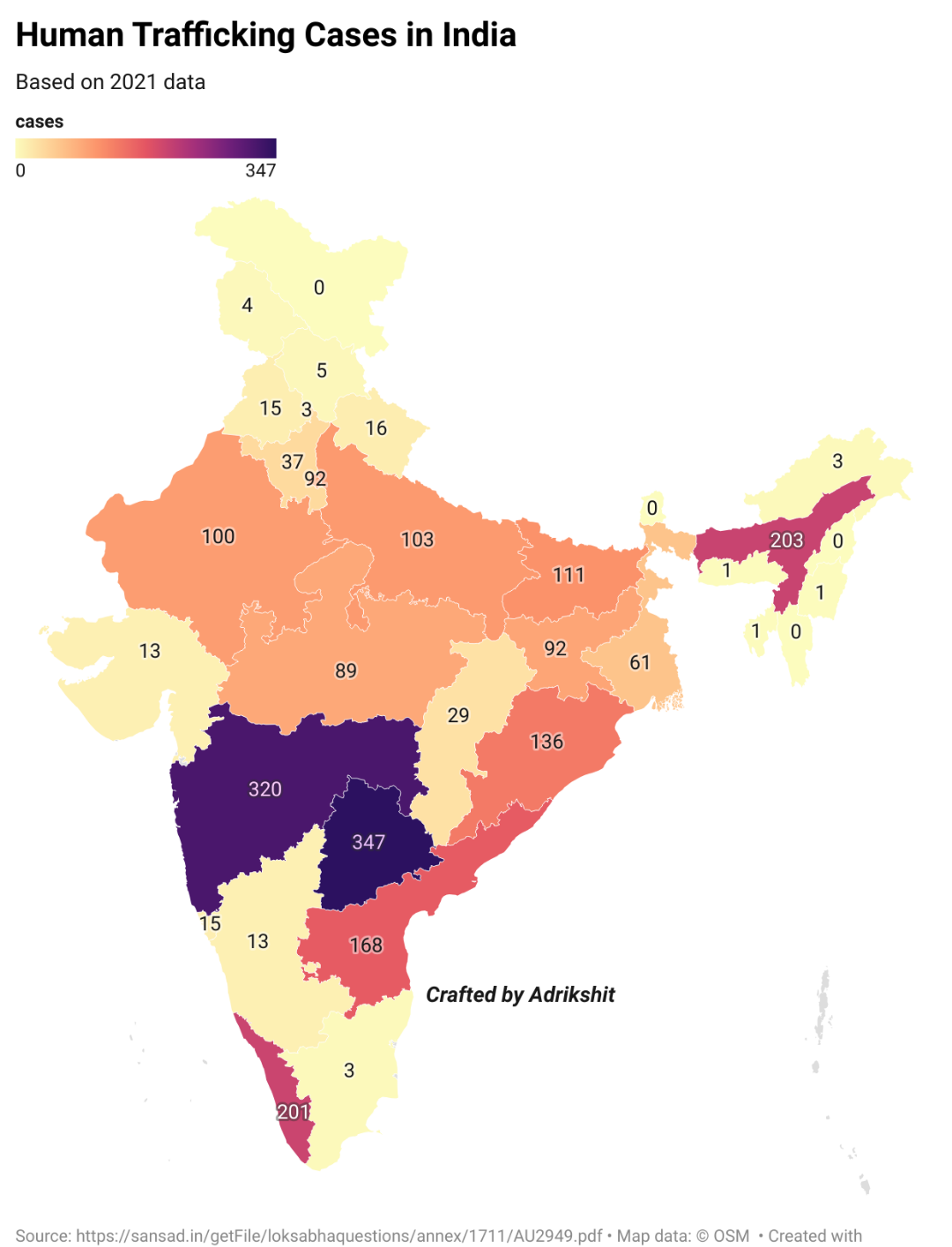Human Trafficking Cases in India Map


David Chen
Data Visualization Specialist
David Chen is an expert in transforming complex geographic datasets into compelling visual narratives. He combines his background in computer science ...
Geographic Analysis
What This Map Shows\nThis map provides a visual representation of human trafficking cases reported across various states in India, highlighting the alarming prevalence of this issue in different regions. Each marked area indicates the frequency and types of trafficking incidents, offering a stark reminder of the challenges faced in combating this grave violation of human rights.
Human trafficking, often referred to as modern slavery, encompasses a range of abuses, including forced labor, sexual exploitation, and the trafficking of children. The map serves as a crucial tool for understanding the geographical distribution of these cases, making it an essential resource for policymakers, NGOs, and the general public alike.
Deep Dive into Human Trafficking in India\nHuman trafficking is a multifaceted issue that affects millions globally, with India being one of the countries significantly impacted. According to the National Crime Records Bureau (NCRB), thousands of cases are reported each year, although the actual numbers may be much higher due to underreporting. In 2021 alone, India recorded over 2,000 cases of trafficking, a number that reflects only a fraction of the reality.
Interestingly, the reasons behind trafficking in India are complex and often rooted in socio-economic factors. Poverty, lack of education, and limited employment opportunities create an environment where individuals, particularly women and children, are vulnerable to exploitation. Additionally, cultural norms and systemic discrimination, particularly against marginalized communities, exacerbate the problem.
The types of trafficking prevalent in India vary significantly. Some regions are notorious for sex trafficking, while others may see higher instances of labor trafficking, including bonded labor in agriculture and construction. According to reports, states like Maharashtra, Uttar Pradesh, and West Bengal are among those with the highest numbers of trafficking cases. In contrast, states such as Himachal Pradesh and Jammu & Kashmir often have lower reported cases, although this could also be indicative of underreporting or lack of awareness.
One particular area of concern is child trafficking, which has seen a steep rise in recent years. Children are often trafficked for labor, sexual exploitation, or even illegal adoptions. The map highlights these hotspots, emphasizing that urban centers, where populations are dense and anonymity is higher, tend to have a higher incidence of child trafficking.
Regional Analysis\nWhen examining the map more closely, it becomes evident that human trafficking is not uniformly distributed across India. For example, the northern states, particularly Uttar Pradesh and Bihar, report significant numbers of trafficking cases. This can be attributed to various factors, such as high poverty rates, large populations, and inadequate law enforcement.
In contrast, southern states like Tamil Nadu and Kerala, while still facing challenges, often show slightly lower rates. What’s fascinating is that these states have implemented more robust social programs aimed at education and women's empowerment, which may contribute to their relatively lower trafficking rates.
The eastern region, particularly West Bengal, has emerged as both a source and destination for trafficking. Many women and children are trafficked from rural areas of West Bengal to urban centers across India, as well as to other countries, including Bangladesh and Nepal. The porous borders and traditional migration patterns complicate efforts to combat this issue.
Interestingly, the map also reveals that some regions, such as the northeastern states, face unique challenges due to their geographical and cultural contexts. These areas often serve as transit points for trafficking networks, complicating enforcement efforts and making it essential to adopt a regional approach to address the issue effectively.
Significance and Impact\nThe significance of addressing human trafficking in India cannot be overstated. Each case represents a life disrupted, a future stolen, and a fundamental human rights violation. The implications of these trafficking cases extend beyond the individuals involved; they impact families, communities, and society as a whole.
Moreover, the economic ramifications are profound. Trafficking undermines legitimate labor markets, perpetuates poverty, and fosters a culture of exploitation. As globalization continues to expand, the need for robust international cooperation in combating trafficking becomes increasingly crucial.
Looking to the future, trends indicate that human trafficking may become more complex. The rise of technology can be both a challenge and an opportunity. While traffickers may exploit digital platforms for recruitment and exploitation, technology also offers tools for better tracking, reporting, and combating these crimes. Initiatives that leverage technology to raise awareness, educate potential victims, and strengthen legal frameworks are essential in the fight against human trafficking.
In conclusion, the map of human trafficking cases in India not only sheds light on a critical issue but also underscores the need for continued vigilance, advocacy, and action. By understanding the geographical dynamics of trafficking, we can better strategize interventions and work toward a future free from this atrocity.
Visualization Details
- Published
- August 16, 2025
- Views
- 122
Comments
Loading comments...